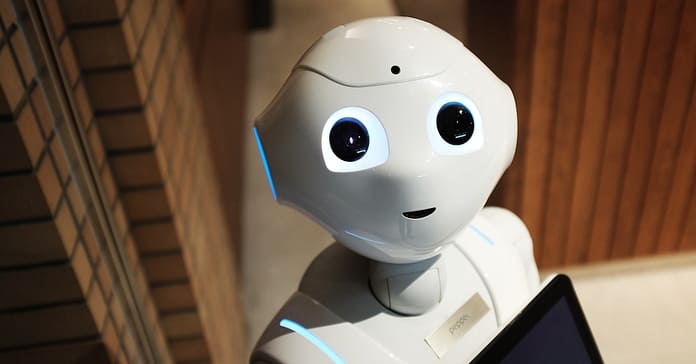Use of artificial intelligence in robotics?
Are you familiar with the use of artificial intelligence in robotics? AI technology is increasing; robotics was introduced in 1950, and today, it is a human self-operating machine. They learned inputs and prevalence, which is omnipresent. Rapidly increasing evolution of artificial intelligence in robotics consuming time in factories for industrial usage. Because now no factor and way available or present where robotics is not used. Meanwhile, machine learning operating systems and robotics are now performing advent and repetitive tasks that humans teach and put the input chips in them. In robotics research papers, people are working on artificial intelligence where Ph.D. scholars share massive AI algorithm changes and potential human vision criteria.
Concept of AI & Robotics

Humanoids come to mind if you see the use of artificial intelligence in robotics. Humanoids of Hollywood AI films and books. In the Hollywood industry, AI is surprising & most significant industry. From the film industry to manufacturing, Industrial, financial, to e-commerce, all are rapid growth of AI. All these changes now every business owner and organization in every sector through components of AI help.
But the AI application in robotics passed the pilot phase and is expected to experience a peak level in upcoming years.
Use of artificial intelligence in robotics applications
In AI, we discuss 3 main applications of artificial intelligence in every field.
AI in E-commerce

In E-commerce now, technology is used for recommendations in browsing history, Interest rates, and customer engines to work.
- Personalized shopping
Personalized shopping using artificial intelligence in robotics helps improve the relationship between seller and buyer to their loyalty brand. That’s why it is built to make compatible preferences and recommendations.
- AI-Powered Assistant
Virtual chatbots and shopping Assistants help to improve the online shopping method. You can ask any query relevant to your purchase and can track your order number. Natural Language processes make the conversation sound personal and real-time engagement. For instance, Amazon, eBay, and Daraz.
- Fraud prevention
E-commerce companies deal with two significant issues, which are fake reviews on stores and using fake debit cards. Through Artificial intelligence robots examples, usage patterns reduce the possibility of fake orders and show accurate data to customers.
AI in education

The use of artificial intelligence in robotics for education purposes has a different place now in the education sector. Although the increase of artificial intelligence slowly increases productivity for students, faculties, and management tasks. Because after the launch of ChatGpt, you can perform your hour’s tasks in minutes with a single command.
This sector includes the following applications:
- Automated administrative tasks for educators
The educational environment is rapidly changing, with technology becoming more and more widespread in classrooms and schools. Artificial intelligence (AI) is one of the key technologies used to help educators manage administrative tasks. AI can automate many mundane and time-consuming activities in running a school or university, freeing teachers to focus on their primary duties—teaching students.
Using AI for administrative tasks saves educators time and allows them to access data quickly and accurately. AI for various processes such as attendance tracking, student management, scheduling classes, and grade book organization. Additionally, AI can provide insights into student performance that may have gone unnoticed. Teachers can then use this data to tailor instruction and meet each student’s needs better.
- Creating Smart Content
AI is becoming increasingly prevalent in our daily lives, and the world of content creation is no exception. AI can help make creating innovative content more effortless than ever by automating repetitive tasks and giving editors access to a wealth of data-driven insights.
AI has been used for various tasks that support intelligent content creation, from natural language processing for automated copywriting to sentiment analysis for finding out how readers feel about specific topics. Content creators can also leverage AI to recommend topics based on reader interest or even automate entire campaigns with dynamic ad placements across multiple channels.
Essentially, AI allows content creators to save time and energy while creating excellent quality work that will resonate with audiences. With the help of AI, they can create more brilliant pieces faster—helping them be better prepared when it comes time to show off their work!
- Voice Assistants
The increasing popularity of voice assistants, such as Apple’s Siri, and Amazon’s Alexa, has primarily been driven by artificial Intelligence (AI) advances. AI is used to power these virtual assistants and enables them to respond quickly and accurately to voice commands. AI also allows these voice assistants to anticipate users’ needs and provide a more personalized experience.
As technology advances, so will the capabilities of AI-powered virtual assistants. In addition to responding quickly to spoken requests, AI enables these digital helpers to understand context-sensitive questions and tasks. However, they can understand what users are asking for based on their conversation history or other data points like location information. Furthermore, Natural Language Processing (NLP) advancements allow virtual assistants like Alexa or Siri to recognize the user’s intent and suggest additional relevant content.
- Personalized Learning
(AI) Artificial Intelligence is transforming the way of work, live, and learn. AI-powered personalized learning solutions make it easier to customize individual students’ education experiences. Personalized learning combines traditional teaching practices with digital technologies and data analysis to create tailored educational experiences that meet each student’s unique needs, interests, and goals.
Using AI, personalized learning can match students with lessons that best fit their abilities and preferences, providing more meaningful engagement in the classroom. AI-driven algorithms can also help teachers personalize instruction to support each student’s development better – from recommending activities and content relevant to a student’s interests to analyzing individual performance data for more effective remediation or acceleration of instruction. Additionally, artificial intelligence is used to identify challenges faced by groups of students so that educators can better understand how they can adjust the classroom environment.
3. Applications of Artificial Intelligence in Lifestyle
The use of Artificial Intelligence in robotics changes influencers’ lives and affects lifestyles. Below are some points
i. Autonomous Vehicles
With the rising advancements in artificial intelligence (AI), autonomous vehicles are becoming a reality. Autonomous vehicles use AI to process data from their surroundings, allowing them to drive safely and efficiently without any human input. AI also enables these vehicles to make decisions based on their environment, such as slowing down when approaching an intersection or merging into traffic.
Not only does AI help with navigation and decision-making, but it can also provide safety features that humans may not be able to detect. For example, sensors connected to the vehicle’s AI system can detect objects that may be out of sight and alert other drivers or passengers accordingly. This technology promises improved safety for everyone on the road, making commuting more manageable and efficient.
ii. Spam Filters
Artificial intelligence is becoming increasingly important in our day-to-day lives. It has been used in various applications, from marketing to self-driving cars, and it’s revolutionizing how we filter out spam emails. AI technology allows us to build more advanced spam filters that detect and stop malicious emails before they ever reach your inbox.
Using AI algorithms, spam filters can analyze email content to determine whether it’s dangerous. They can recognize patterns in phrases, words, and images to identify suspicious activity like phishing scams or viruses. With its ability to quickly analyze large amounts of data, Artificial Intelligence enables us to create more competent and efficient spam filters that protect our valuable information from cybercriminals.
iii. Facial Recognition
From unlocking our smartphones to tracking down criminals, Artificial Intelligence (AI) is making facial recognition technology more innovative and more accurate than ever. Facial recognition powered by AI uses computer algorithms to identify unique features of a face, like eyes, nose, mouth, chin shape, or hairline. Technology can accurately find matches between two images of faces and determine if they’re the same person.
It can also compare faces against vast databases to quickly detect individuals with precision and accuracy, all within seconds. Companies are increasingly using this technology for security purposes like access control and marketing initiatives such as targeted ads based on demographic information gathered from facial recognition imagery.
Robotics and artificial intelligence engineering

artificial intelligence and Robotics engineering is an exciting field of study that offers many opportunities for those seeking to design and create the future. Robotics and AI engineering students are at the forefront of innovation, developing intelligent robots with purposeful tasks that can help make life easier. Field emphasizes problem-solving, creativity, and critical thinking as engineers seek to build strong communication between robotics and humans.
At many universities, robotics programs allow students to gain knowledge through hands-on experience in labs. Students use state-of-the-art software tools to develop algorithms that enable robots to interact with their environment or program them to complete specific tasks autonomously. These experiences offer invaluable insight into how robots work in real-world scenarios, which apply in various industries such as healthcare, retail, or automotive manufacturing.
Read Also: Will Artificial Intelligence Replace Humans? AI and the Future of Work
Takeaway: Use of artificial intelligence in robotics
The use of Artificial intelligence in robotics has resulted in increased accuracy, improved safety, and enhanced productivity. With AI-based vision systems, robots can now identify objects, recognize patterns, and even make decisions based on what they see. Similarly, AI-powered motion planning algorithms enable robots to navigate unknown environments easily. Additionally, AI-enabled natural language understanding capabilities allow for more efficient communication between humans and machines.

